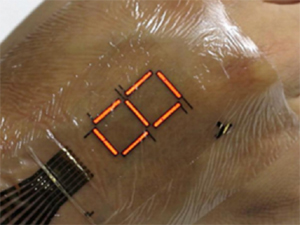



Date:18/04/16
 Researchers from the University of Tokyo have created a protective layer of organic material that’s ultrathin and ultraflexible. And they have demonstrated the material’s usefulness by making an OLED display that’s air-stable. This opens the possibility of developing better electronic skin displays, the next major leap in wearable technology.
Researchers from the University of Tokyo have created a protective layer of organic material that’s ultrathin and ultraflexible. And they have demonstrated the material’s usefulness by making an OLED display that’s air-stable. This opens the possibility of developing better electronic skin displays, the next major leap in wearable technology.
The thickness (or rather, thinness) and flexibility of wearable electronics is an essential factor in its further development. Plastic substrates are commonly used in the creation of such devices, which still require millimeter-scale thick glass. Also, whenever micrometer-scale and flexible organic materials are developed, they aren’t reliably stable when exposed to air.
That is, they weren’t, until a group of researchers led by Professor Takao Someya and Dr. Tomoyuki Yokota created high-quality protective film that’s under two micrometers thin using alternating layers of Silicon Oxynitrite and Parylene. The film kept oxygen and water vapor from passing through and could be attached to indium tin oxide (ITO) electrodes, which are used in flat-panel displays and smart windows.
“What would the world be like if we had displays that could adhere to our bodies and even show our emotions or level of stress or unease,” asks Professor Someya. Ultimately, this is the question that fueled the development of the material.
The researchers were able to create polymer light-emitting diodes (PLEDs) and organic photodetectors (OPDs) by using this new protective film.
The material has also reduced heat generation and consumes less power, which is ideal for medical use, such has for monitoring a pulse rate or monitoring blood oxygen levels when attached to the skin.
New 'e-skin' tech turns your body into a walking display
 Researchers from the University of Tokyo have created a protective layer of organic material that’s ultrathin and ultraflexible. And they have demonstrated the material’s usefulness by making an OLED display that’s air-stable. This opens the possibility of developing better electronic skin displays, the next major leap in wearable technology.
Researchers from the University of Tokyo have created a protective layer of organic material that’s ultrathin and ultraflexible. And they have demonstrated the material’s usefulness by making an OLED display that’s air-stable. This opens the possibility of developing better electronic skin displays, the next major leap in wearable technology.The thickness (or rather, thinness) and flexibility of wearable electronics is an essential factor in its further development. Plastic substrates are commonly used in the creation of such devices, which still require millimeter-scale thick glass. Also, whenever micrometer-scale and flexible organic materials are developed, they aren’t reliably stable when exposed to air.
That is, they weren’t, until a group of researchers led by Professor Takao Someya and Dr. Tomoyuki Yokota created high-quality protective film that’s under two micrometers thin using alternating layers of Silicon Oxynitrite and Parylene. The film kept oxygen and water vapor from passing through and could be attached to indium tin oxide (ITO) electrodes, which are used in flat-panel displays and smart windows.
“What would the world be like if we had displays that could adhere to our bodies and even show our emotions or level of stress or unease,” asks Professor Someya. Ultimately, this is the question that fueled the development of the material.
The researchers were able to create polymer light-emitting diodes (PLEDs) and organic photodetectors (OPDs) by using this new protective film.
The material has also reduced heat generation and consumes less power, which is ideal for medical use, such has for monitoring a pulse rate or monitoring blood oxygen levels when attached to the skin.
Views: 512
©ictnews.az. All rights reserved.Similar news
- Justin Timberlake takes stake in Facebook rival MySpace
- Wills and Kate to promote UK tech sector at Hollywood debate
- 35% of American Adults Own a Smartphone
- How does Azerbaijan use plastic cards?
- Imperial College London given £5.9m grant to research smart cities
- Search and Email Still the Most Popular Online Activities
- Nokia to ship Windows Phone in time for holiday sales
- Internet 'may be changing brains'
- Would-be iPhone buyers still face weeks-long waits
- Under pressure, China company scraps Steve Jobs doll
- Jobs was told anti-poaching idea "likely illegal"
- Angelic "Steve Jobs" loves Android in Taiwan TV ad
- Kinect for Windows gesture sensor launched by Microsoft
- Kindle-wielding Amazon dips toes into physical world
- Video game sales fall ahead of PlayStation Vita launch





















